Pethia gelius
Golden Dwarf Barb
SynonymsTop ↑
Cyprinus gelius Hamilton, 1822; Puntius gelius (Hamilton, 1822); Cyprinus canius Hamilton, 1822
Etymology
Pethia: the generic vernacular name for small cyprinids in the Sinhala language.
gelius: appears to follow a local vernacular name for the fish.
Classification
Order: Cypriniformes Family: Cyprinidae
Distribution
Described from ‘Ponds and ditches of northeastern Bengal’, and generally considered native to the Ganges and Brahmaputra river drainages in northern India, Nepal, and Bangladesh.
Records from this century suggest a much wider range, however, with confirmed occurrences in Tamil Nadu state, southern India, and the Ayeyarwaddy River delta region, Myanmar although the latter records may warrant investigation.
Some aspects of colour pattern and morphology vary depending on locality.
Habitat
Tends to inhabit sluggish, often turbid, enironments with substrates of mud or silt as well as marginal zones of flowing rivers and tributaries.
In West Bengal state, for example, it’s typically found in slow-moving, shallow streams passing through cultivated land such as rice fields and which may or may not contain aquatic vegetation.
Many of its habitats are subject to seasonal variation in water depth, flow and turbidity.
Maximum Standard Length
35 – 40 mm.
Aquarium SizeTop ↑
Base dimensions of at least 60 ∗ 30 cm or equivalent are required.
Maintenance
Best kept in a densely-planted tank and is an excellent choice for the carefully-aquascaped set-up.
The addition of some floating plants and driftwood roots or branches to diffuse the light entering the tank also seems to be appreciated and adds a more natural feel.
Filtration does not need to be particularly strong as it is likely to hail from sluggish waters and may struggle if there is a fast current.
Do not add this fish to a biologically immature tank as it can be susceptible to swings in water chemistry.
Water Conditions
Temperature: 18 – 24 °C
pH: 6.0 – 7.0
Hardness: 18 – 179 ppm
Diet
Naturally a micropredator feeding on small insects, worms, crustaceans and other zooplankton in nature.
In the aquarium it will accept dried foods of a suitable size but should not be fed these exclusively.
Daily meals of small live and frozen fare such as Daphnia, Artemia, etc., along with good quality flakes and granules will result in the best colouration and encourage the fish to come into breeding condition.
P. gelius is frequently emaciated post-import and may require an acclimatisation period during which it’s able to feed in the absence of competitors.
Behaviour and CompatibilityTop ↑
Very peaceful but does not make an ideal community fish due to its small size and rather timid nature.
It will do best when maintained alone or with other diminutive species such as Microdevario, Trigonostigma, smaller Danio, Lepidocephalichthys, and freshwater shrimp of the genera Caridina and Neocaridina.
It’s a schooling species by nature and really should be kept in a group of at least 8-10 specimens.
Maintaining it in decent numbers will not only make the fish less nervous but will result in a more effective, natural-looking display, plus males will also display their best colours and some interesting behaviour as they compete with one other for female attention.
Sexual Dimorphism
Mature females are noticeably rounder-bellied, often a little larger and less-intensively coloured than males.
Reproduction
Like most small cyprinids Pethia spp. are egg-scattering free spawners exhibiting no parental care.
When in good condition they will spawn often and in a mature aquarium it’s possible that small numbers of fry may start to appear without intervention.
However if you want to maximise yield a more controlled approach is required.
The adult group can still be conditioned together but a smaller aquarium should also be set up and filled with mature water.
This should be very dimly lit and the base covered with some kind of mesh of a large enough grade so that the eggs can fall through but small enough so that the adults cannot reach them. The widely available plastic ‘grass’-type matting can also be used and works well, as does a layer of glass marbles.
Alternatively filling much of the tank with a fine-leaved plant such as Taxiphyllum spp. or spawning mops can also return decent results.
The water itself should be of slightly acidic to neutral pH with a temperature towards the upper end of the range suggested above, and an air-powered sponge filter or air stone(s) should also be included to provide oxygenation and water movement.
When the adults are well-conditioned and the females appear gravid one or two pairs should then be introduced, and spawning should take place the following morning.
An alternative is to spawn the fish in a group with half a dozen specimens of each sex being a good number, although a larger aquarium may be necessary.
In either situation the adults will probably eat the eggs given the chance and should be removed as soon as any are noticed.
These should hatch in 24-36 hours with the fry free swimming after 3-4 days.
They should be fed on an infusoria-grade food for the first few days until large enough to accept microworm, Artemia nauplii, or suchlike.
NotesTop ↑
This species’ identity was settled and a neotype designated by Knight (2013) who also revalidated the congener P. canius (Hamilton, 1822) and described the closely-related P. aurea.
These three had previously been considered to represent phenotypes of P. gelius, albeit on a tentative basis, with the validity of P. canius having been discussed since the late 19th century.
P. gelius and P. canius were both described by Hamilton (1822) and share the type locality of ‘northeastern Bengal’. Although Hamilton did not provide drawings M’Clelland (1839) included colour illustrations depicting two quite different-looking species.
However, the only discernible differences in their original descriptions are that P. gelius is ‘yellowish’ and possesses 8 anal-fin rays whereas P. canius is ‘reddish’ and has 7 anal-fin rays, and the latter has been considered a synonym of the former since Day (1878), although this has been ignored by certain authors.
P. gelius, P. canius and P. aurea are now considered to form a group of closely-related species which can be told apart from other members of the genus Pethia by the following combination of characters following Knight (2013): lateral line incomplete with 3-4 pored scales; 20-26 scales in lateral series; ½4–5/1/2–3½ scales in transverse line on body; 8-9 predorsal scales; barbels absent; colour pattern comprising 2-3 black blotches on the body in life (fading in preserved specimens), the first behind the opercle, second beneath the dorsal-fin origin and extending to midbody, and third above the anal-fin origin, plus a black spot at the base of the dorsal and anal fins.
In addition P. gelius is distinguished from all other Pethia species by the following combination: lateral line incomplete with 3-4 pored scales; 21–22 + 1 scales in lateral series, ½4/1/2½ scales in transverse line on body; 8 predorsal scales; last unbranched dorsal-fin ray thick, straight, and serrated, with 20–25 serrae on posterior margin; barbels absent; a broad black band around the caudal peduncle covering scales 19–21 in the longitudinal series; three diffuse black blotches on the body, first behind opercle, second below dorsal-fin origin, third above anal-fin origin; a black spot at base and origins of dorsal, anal and pelvic fins.
In live specimens the body is pale yellow in colour and the dorsal, pelvic and anal fins bright yellow whereas in P. canius the body is reddish, dorsal and caudal fins red and anal-fin yellowish-orange, and in P. aurea the body is yellowish-golden, dorsal-fin back with a pale yellow base and all other fins hyaline.
P. gelius was formerly included in the Puntius conchonius ‘group’ of closely-related species alongside P. ater, P. bandula, P. conchonius, P. cumingii, P. didi, P. erythromycter, P. khugae, P. macrogramma, P. manipurensis, P. meingangbii, P. nankyweensis, P. nigripinnis, P. nigrofasciatus, P. padamya, P. phutunio, P. punctatus, P. reval, P. shalynius, P. stoliczkanus, P. thelys, P. tiantian, and P. ticto, but all of these were moved to the new genus Pethia by Pethiyagoda et al. (2012), as were P. melanomaculata, P. pookodensis, P. muvattupuzhaensis, P. ornatus, and P. yuensis.
Pethia species are defined by the following combination of characters: rostral barbels absent; maxillary barbels minute or absent; possession of a stiff, serrated last unbranched dorsal-fin ray; presence of a black blotch on the caudal peduncle, and frequently, black blotches, spots or bars on the side of the body; infraorbital 3 deep and partially overlapping the preoperculum.
The genus Puntius was viewed as a polyphyletic catch-all containing over 100 species of small to mid-sized cyprinid for a number of years until Pethiyagoda et al. (2012) published a partial review covering South Asian members.
The majority of sub-Himalayan Puntius species were reclassified and new genera Dawkinsia, Dravidia, and Pethia erected to accomodate some of them, with the remainder either retained in Puntius or moved to the existing Systomus assemblage, though the definition of the latter was altered meaning some Southeast Asian species formerly placed there are no longer members.
It subsequently became clear that the name Dravidia was preoccupied by a genus of flesh fly, therefore the replacement name Haludaria was made available by Pethiyagoda (2013).
No species from Indochina, China, or Indonesia were included in the study meaning a significant number of former Puntius are currently classed as incertae sedis, i.e., of uncertain taxonomic placement, and this also applies to a number of South Asian species of unresolved status.
They’re perhaps best referred to as ‘Puntius‘ for the time being whereby the genus name is surrounded by quotation marks to denote its questionable usage, and that is the convention used here on SF at the moment.
References
- Hamilton, F., 1822 - Edinburgh & London: i-vii + 1-405
An account of the fishes found in the river Ganges and its branches. - Arunkumar, L. and H. T. Tombi Singh, 2003 - Journal of the Bombay Natural History Society 99(3): 481-487
Two new species of puntiid fish from the Yu River system of Manipur. - Knight, J. D. M., 2010 - Journal of Threatened Taxa 2(3): 786-787
Note: On a record of Puntius gelius (Hamilton, 1822) (Teleostei: Cypriniformes: Cyprinidae) from Tamil Nadu. - Knight, J. D. M., 2013 - Zootaxa 3700(1): 173-184
Pethia aurea (Teleostei: Cyprinidae), a new species of barb from West Bengal, India, with redescription of P. gelius and P. canius. - Kullander, S. O. and F. Fang, 2005 - Copeia 2005(2): 290-302
Two new species of Puntius from northern Myanmar (Teleostei: Cyprinidae). - McClelland, J., 1839 - Asiatic Researches 19(2): 217-471, Pls. 37-61
Indian Cyprinidae. - Pethiyagoda, R., 2013 - Zootaxa 3646(2): 199
Haludaria, a replacement generic name for Dravidia (Teleostei: Cyprinidae). - Pethiyagoda, R., M. Meegaskumbura, and K. Maduwage, 2012 - Ichthyological Exploration of Freshwaters 23(1): 69-95
A synopsis of the South Asian fishes referred to Puntius (Pisces: Cyprinidae). - Vishwanath, W. and J. Laisram, 2004 - Journal of the Bombay Natural History Society 101(1): 130-137
Two new species of Puntius Hamilton-Buchanan (Cypriniformes: Cyprinidae) from Manipur, India, with an account of Puntius species from the state.
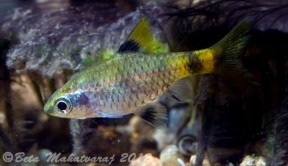
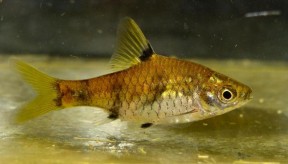
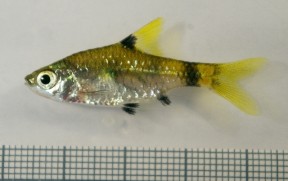
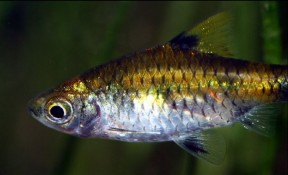
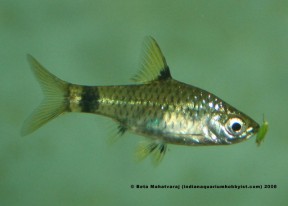
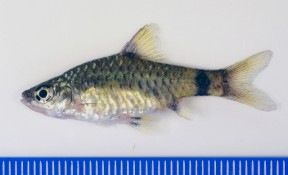


September 21st, 2013 at 10:15 pm
Hi Matt , Marc Knights paper on the differences between Gelius and Canius and the addition of the newly described P. aurea really make identification of these three small Barbs easier !
I had long believed Aurea to be the true Gelius 🙂 !
September 23rd, 2013 at 4:28 pm
Hi Andy thanks for the heads up – it’s on my list for the near future!
October 25th, 2013 at 11:55 pm
Now done.